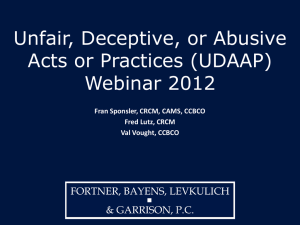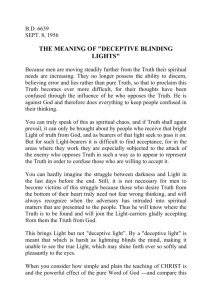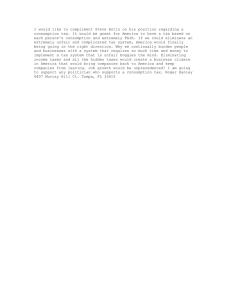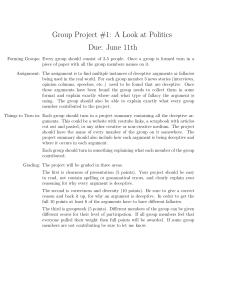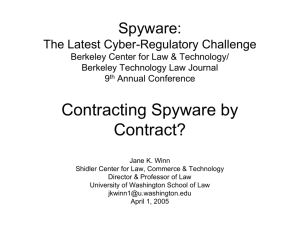Unfair, Deceptive, or Abusive Acts or Practices
advertisement
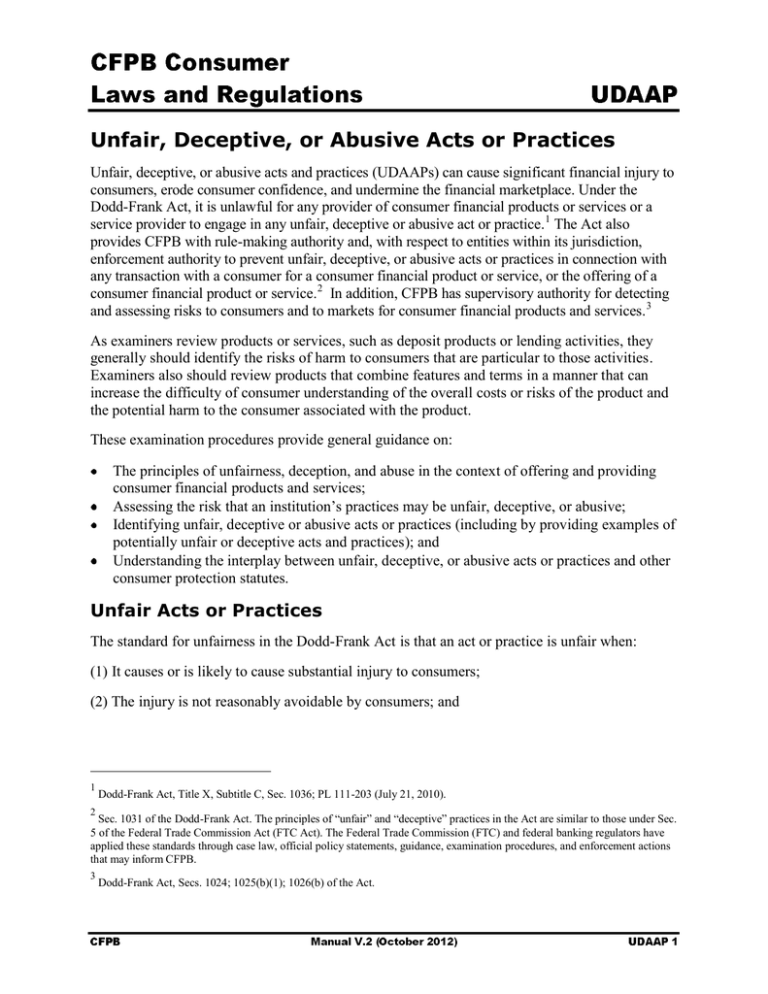
Unfair, Deceptive, or Abusive Acts or Practices Unfair, deceptive, or abusive acts and practices (UDAAPs) can cause significant financial injury to consumers, erode consumer confidence, and undermine the financial marketplace. Under the Dodd-Frank Act, it is unlawful for any provider of consumer financial products or services or a service provider to engage in any unfair, deceptive or abusive act or practice. 1 The Act also provides CFPB with rule-making authority and, with respect to entities within its jurisdiction, enforcement authority to prevent unfair, deceptive, or abusive acts or practices in connection with any transaction with a consumer for a consumer financial product or service, or the offering of a consumer financial product or service. 2 In addition, CFPB has supervisory authority for detecting and assessing risks to consumers and to markets for consumer financial products and services. 3 As examiners review products or services, such as deposit products or lending activities, they generally should identify the risks of harm to consumers that are particular to those activities. Examiners also should review products that combine features and terms in a manner that can increase the difficulty of consumer understanding of the overall costs or risks of the product and the potential harm to the consumer associated with the product. These examination procedures provide general guidance on: The principles of unfairness, deception, and abuse in the context of offering and providing consumer financial products and services; Assessing the risk that an institution’s practices may be unfair, deceptive, or abusive; Identifying unfair, deceptive or abusive acts or practices (including by providing examples of potentially unfair or deceptive acts and practices); and Understanding the interplay between unfair, deceptive, or abusive acts or practices and other consumer protection statutes. Unfair Acts or Practices The standard for unfairness in the Dodd-Frank Act is that an act or practice is unfair when: (1) It causes or is likely to cause substantial injury to consumers; (2) The injury is not reasonably avoidable by consumers; and 1 Dodd-Frank Act, Title X, Subtitle C, Sec. 1036; PL 111-203 (July 21, 2010). 2 Sec. 1031 of the Dodd-Frank Act. The principles of “unfair” and “deceptive” practices in the Act are similar to those under Sec. 5 of the Federal Trade Commission Act (FTC Act). The Federal Trade Commission (FTC) and federal banking regulators have applied these standards through case law, official policy statements, guidance, examination procedures, and enforcement actions that may inform CFPB. 3 Dodd-Frank Act, Secs. 1024; 1025(b)(1); 1026(b) of the Act. (3) The injury is not outweighed by countervailing benefits to consumers or to competition. 4 The act or practice must cause or be likely to cause substantial injury to consumers. Substantial injury usually involves monetary harm. Monetary harm includes, for example, costs or fees paid by consumers as a result of an unfair practice. 5An act or practice that causes a small amount of harm to a large number of people may be deemed to cause substantial injury. Actual injury is not required in every case. A significant risk of concrete harm is also sufficient. However, trivial or merely speculative harms are typically insufficient for a finding of substantial injury. Emotional impact and other more subjective types of harm also will not ordinarily amount to substantial injury. Nevertheless, in certain circumstances, such as unreasonable debt collection harassment, emotional impacts may amount to or contribute to substantial injury. Consumers must not be reasonably able to avoid the injury. An act or practice is not considered unfair if consumers may reasonably avoid injury. Consumers cannot reasonably avoid injury if the act or practice interferes with their ability to effectively make decisions or to take action to avoid injury. Normally the marketplace is self-correcting; it is governed by consumer choice and the ability of individual consumers to make their own private decisions without regulatory intervention. If material information about a product, such as pricing, is modified after, or withheld until after, the consumer has committed to purchasing the product; however, the consumer cannot reasonably avoid the injury. Moreover, consumers cannot avoid injury if they are coerced into purchasing unwanted products or services or if a transaction occurs without their knowledge or consent. A key question is not whether a consumer could have made a better choice. Rather, the question is whether an act or practice hinders a consumer’s decision-making. For example, not having access to important information could prevent consumers from comparing available alternatives, choosing those that are most desirable to them, and avoiding those that are inadequate or unsatisfactory. In addition, if almost all market participants engage in a practice, a consumer’s incentive to search elsewhere for better terms is reduced, and the practice may not be reasonably avoidable. 6 The actions that a consumer is expected to take to avoid injury must be reasonable. While a consumer might avoid harm by hiring independent experts to test products in advance or by bringing legal claims for damages in every case of harm, these actions generally 4 The standard for unfairness in the Dodd-Frank Act has the same three-part test as the FTC Act. This standard was first stated in the FTC Policy Statement on Unfairness (Dec. 17, 1980), available at: http://www ftc.gov/bcp/policystmt/ad-unfair htm. Congress later amended the FTC Act to include this specific standard in the Act itself. 15 U.S.C. § 45(n). 5 6 FTC Policy Statement on Unfairness, at p. 3. See Credit Practices Rule, 49 Fed. Reg. 7740, 7746 (1984). would be too expensive to be practical for individual consumers and, therefore, are not reasonable. The injury must not be outweighed by countervailing benefits to consumers or competition. To be unfair, the act or practice must be injurious in its net effects — that is, the injury must not be outweighed by any offsetting consumer or competitive benefits that also are produced by the act or practice. Offsetting consumer or competitive benefits of an act or practice may include lower prices to the consumer or a wider availability of products and services resulting from competition. Costs that would be incurred for measures to prevent the injury also are taken into account in determining whether an act or practice is unfair. These costs may include the costs to the institution in taking preventive measures and the costs to society as a whole of any increased burden and similar matters. Public policy, as established by statute, regulation, judicial decision, or agency determination, may be considered with all other evidence to determine whether an act or practice is unfair. However, public policy considerations by themselves may not serve as the primary basis for determining that an act or practice is unfair. Examples The examples described below stem from federal enforcement actions. They provide insight into practices that have been alleged to be unfair by other regulators and may inform CFPB’s determinations. However, the particular facts in a case are crucial to a determination of unfairness. It is important to bear in mind that a change in facts could change the appropriate determination. Moreover, the brief summaries below do not present all of the material facts relevant to the determinations in each case. The examples show how the unfairness standard may be applied. Refusing to release lien after consumer makes final payment on a mortgage.7 The FTC brought an enforcement action against a mortgage company based on allegations, described below, that repeatedly failed to release liens after consumers fully paid the amount due on their mortgages. Substantial injury. Consumer’s sustained economic injury when the mortgage servicer did not release the liens on their properties after the consumers had repaid the total amount due on the mortgages. Not outweighed by benefits. Countervailing benefits to competition or consumers did not result from the servicer’s alleged failure to appropriately service the mortgage loan and release the lien promptly. 7 FTC v. Capital City Mortgage Corp., Civil No. 98 CV-237 (D.D.C. Feb. 2005), available at http://www ftc.gov/opa/2005/02/capitalcity.shtm. Not reasonably avoidable. Consumers had no way to know in advance of obtaining the loan that the mortgage servicer would not release the lien after full payment. Moreover, consumers generally cannot avoid the harm caused by an improper practice of a mortgage servicer because the servicer is chosen by the owner of the loan, not the borrower. Thus, consumers cannot choose their loan servicer and cannot change loan servicers when they are dissatisfied with the quality of the loan servicing. Dishonoring credit card convenience checks without notice. 8 The OTS and FDIC brought enforcement actions against a credit card issuer that sent convenience checks with stated credit limits and expiration dates to customers. For a significant percentage of consumers, the issuer reduced credit lines after the checks were presented, and then the issuer dishonored the consumers’ checks. Substantial injury. Customers paid returned-check fees and may have experienced a negative impact on credit history. Not outweighed by benefits. The card issuer later reduced credit limits based on credit reviews. Based on the particular facts involved in the case, the harm to consumers from the dishonored convenience checks outweighed any benefit of using new credit reviews. Not reasonably avoidable. Consumers reasonably relied on their existing credit limits and expiration dates on the checks when deciding to use them for a payment. Consumers had received no notice that the checks they used were being dishonored until they learned from the payees. Thus, consumers could not reasonably have avoided the injury. Processing payments for companies engaged in fraudulent activities. 9 The OCC brought an enforcement action in a case involving a bank that maintained deposit account relations with telemarketers and payment processors, based on the following allegations. The telemarketers regularly deposited large numbers of remotely created checks drawn against consumers’ accounts. A large percentage of the checks were not authorized by consumers. The bank failed to establish appropriate policies and procedures to prevent, detect, or remedy such activities. Substantial injury. Consumers lost money from fraudulent checks created remotely and drawn against their accounts. Not outweighed by benefits. The cost to the bank of establishing a minimum level of due diligence, monitoring, and response procedures sufficient to remedy the problem would have been far less than the amount of injury to consumers that resulted from the bank’s avoiding those costs. 8 In re American Express Bank, FSB (Cease and Desist Order WN-09-016, and Order of Assessment of a Civil Money Penalty for $250,000, WN-09-017, June 29, 2009) OTS Docket No. 15648; In re American Express Centurion Bank, (Cease and Desist Order, June 30, 2009) Docket FDIC-09-251b, available at http://www fdic.gov/news. 9 In re Wachovia Bank, National Association, available at http://www.occ.treas.gov Not reasonably avoidable. Consumers could not avoid the harm because the harm resulted principally from transactions to which the consumers had not consented. Deceptive Acts or Practices A representation, omission, actor practice is deceptive when (1) The representation, omission, act, or practice misleads or is likely to mislead the consumer; (2) The consumer’s interpretation of the representation, omission, act, or practice is reasonable under the circumstances; and (3) The misleading representation, omission, act, or practice is material. 10 There must be a representation, omission, act, or practice that misleads or is likely to mislead the consumer. Deception is not limited to situations in which a consumer has already been misled. Instead, an act or practice may be deceptive if it is likely to mislead consumers. It is necessary to evaluate an individual statement, representation, or omission not in isolation, but rather in the context of the entire advertisement, transaction, or course of dealing, to determine whether the overall net impression is misleading or deceptive. A representation may be an express or implied claim or promise, and it may be written or oral. If material information is necessary to prevent a consumer from being misled, it may be deceptive to omit that information. Written disclosures may be insufficient to correct a misleading statement or representation, particularly where the consumer is directed away from qualifying limitations in the text or is counseled that reading the disclosures is unnecessary. Likewise, oral or fine print disclosures or contract disclosures may be insufficient to cure a misleading headline or a prominent written representation. Similarly, a deceptive act or practice may not be cured by subsequent truthful disclosures. Acts or practices that may be deceptive include: making misleading cost or price claims; offering to provide a product or service that is not in fact available; using bait-and-switch techniques; omitting material limitations or conditions from an offer; or failing to provide the promised services. The FTC’s “four Ps” test can assist in the evaluation of whether a representation, omission, act, or practice is likely to mislead: o Is the statement prominent enough for the consumer to notice? 10 See FTC Policy Statement on Deception, available at http://www.ftc.gov/bcp/policystmt/ad-decept.htm. Examiners should be informed by the FTC’s standard for deception. o Is the information presented in an easy-to-understand format that does not contradict other information in the package and at a time when the consumer’s attention is not distracted elsewhere? o Is the placement of the information in a location where consumers can be expected to look or hear? o Finally, is the information in close proximity to the claim it qualifies? 11 The representation, omission, act, or practice must be considered from the perspective of the reasonable consumer. In determining whether an act or practice is misleading, one also must consider whether the consumer’s interpretation of or reaction to the representation, omission, act, or practice is reasonable under the circumstances. In other words, whether an act or practice is deceptive depends on how a reasonable member of the target audience would interpret the representation. When representations or marketing practices target a specific audience, such as older Americans, young people, or financially distressed consumers, the communication must be reviewed from the point of view of a reasonable member of that group. Moreover, a representation may be deceptive if the majority of consumers in the target class do not share the consumer’s interpretation, so long as a significant minority of such consumers is misled. When a seller’s representation conveys more than one meaning to reasonable consumers, one of which is false, the seller is liable for the misleading interpretation. Exaggerated claims or “puffery,” however, are not deceptive if the claims would not be taken seriously by a reasonable consumer. The representation, omission, or practice must be material. A representation, omission, act, or practice is material if it is likely to affect a consumer’s choice of, or conduct regarding, the product or service. Information that is important to consumers is material. Certain categories of information are presumed to be material. In general, information about the central characteristics of a product or service – such as costs, benefits, or restrictions on the use or availability – is presumed to be material. Express claims made with respect to a financial product or service are presumed material. Implied claims are presumed to be material when evidence shows that the institution intended to make the claim (even though intent to deceive is not necessary for deception to exist). 11 FTC, Dot Com Disclosures, Information about On-Line Advertising, available at: http://business ftc.gov/documents/bus41-dotcom-disclosures-information-about-online-advertising.pdf. Claims made with knowledge that they are false are presumed to be material. Omissions will be presumed to be material when the financial institution knew or should have known that the consumer needed the omitted information to evaluate the product or service. If a representation or claim is not presumed to be material, it still would be considered material if there is evidence that it is likely to be considered important by consumers. Examples The examples described below stem from federal enforcement actions. They provide insight into practices that have been alleged to be deceptive by other regulators and may inform CFPB’s determinations. However, as with unfairness, the particular facts in a case are crucial to a determination of deception. It is important to bear in mind that a change in facts could change the appropriate determination. Moreover, the brief summaries below do not present all of the material facts relevant to the determinations in each case. The examples show how the deception standard may be applied. Inadequate disclosure of material lease terms in television advertising. 12 The FTC brought actions against vehicle leasing companies alleging that their television advertisements represented that consumers could lease vehicles for “$0 down” when advertising a monthly lease payment. However, the FTC alleged that the “blur” of “unreadable fine print” that flashed on the screen at the end of the advertisement disclosed costs of at least $1,000. The settlements prohibited the vehicle leasing companies from misrepresenting the amount consumers must pay when signing the lease. In addition, the FTC required that if the companies make any representation about the amounts due at lease signing, or that there is “no down payment,” the companies must make an equally prominent (readable and audible) disclosure of the total amount of all fees due when consumers sign the lease. Representation or omission likely to mislead. The television advertisements featured prominent statements of “no money down” or “$0 down” at lease signing. The advertisement also contained, at the bottom of the screen, a “blur” of small print in which disclosures of various costs required by Regulation M (the Consumer Leasing Act) were made. The FTC alleged that the disclosures were inadequate because they were not clear, prominent, or audible to consumers. Reasonable consumer perspective. A reasonable consumer would believe that he did not have to put any money down and that all he owed was the regular monthly payment. Material representation. The stated “no money down” or “$0 down” plus the low monthly lease payment were material representations to consumers. The fact that the additional, 12 In the matters of Mazda Motor of America, Inc.; Mitsubishi Motor Sales of America, Inc.; American Honda Motor Company, Inc.; General Motors Corporation; American Isuzu Motors, Inc., available at http://www.ftc.gov/opa/1997/02/petapp09.shtm. material costs were disclosed at signing of the lease did not cure the deceptive failure to disclose in the television advertising, the FTC claimed. Misrepresentation about loan terms. 13 In 2004, the FTC sued a mortgage broker advertising mortgage refinance loans at “3.5% fixed payment 30-year loan” or “3.5% fixed payment for 30 years,” implying that the offer was for a 30-year loan with a 3.5% fixed interest rate. Instead, the FTC claimed that the broker offered adjustable rate mortgages (ARMs) with an option to pay various amounts, including a minimum monthly payment that represented only a portion of the required interest. As a result, unpaid interest was added to the principal of the loan, resulting in negative amortization. 14 Practice likely to mislead. The FTC claimed that the advertisements were misleading because they compared payments on a mortgage that fully amortized to payments on a nonamortizing loan with payments that increased after the first year. In addition, the FTC claimed that after application, the broker provided Truth in Lending Act (TILA) disclosures that misstated the annual percentage rate (APR) and that failed to state that the loan was a variable rate loan. Reasonable consumer perspective. It was reasonable for consumers to believe that they would obtain fixed-rate mortgages, based on the representations. Material representation. The representations were material because consumers relied on them when making the decision to refinance their fully amortizing 30-year fixed loans. As a result, the consumers ended up with adjustable rate mortgages that would negatively amortize if they made payments at the stated 3.5% payment rate. 13 FTC v. Chase Financial Funding, Inc., No. SACV04-549 (C.D.Cal. 2004), Stipulated Preliminary Injunction, available at http://www ftc.gov/os/caselist/0223287/0223287.shtm. 14 In 2008, amendments to the Truth in Lending Act’s Regulation Z were adopted to prohibit certain advertising practices, such as misleading advertising of fixed rates and payments, for credit secured by a dwelling. Similar practices could be identified as deceptive in other product lines. See 73 Fed. Reg. 44522 (July 30, 2008) (promulgating 12 CFR 226.24), which has since been recodified as 12 CFR 1026.24. Abusive Acts or Practices The Dodd-Frank Act makes it unlawful for any covered person or service provider to engage in an “abusive act or practice.” 15 An abusive act or practice: Materially interferes with the ability of a consumer to understand a term or condition of a consumer financial product or service or Takes unreasonable advantage of: o A lack of understanding on the part of the consumer of the material risks, costs, or conditions of the product or service; o The inability of the consumer to protect its interests in selecting or using a consumer financial product or service; or o The reasonable reliance by the consumer on a covered person to act in the interests of the consumer. Although abusive acts also may be unfair or deceptive, examiners should be aware that the legal standards for abusive, unfair, and deceptive each are separate. The Role of Consumer Complaints in Identifying Unfair, Deceptive, or Abusive Acts or Practices Consumer complaints play a key role in the detection of unfair, deceptive, or abusive practices. Consumer complaints have been an essential source of information for examinations, enforcement, and rule-making for regulators. As a general matter, consumer complaints can indicate weaknesses in elements of the institution’s compliance management system, such as training, internal controls, or monitoring. While the absence of complaints does not ensure that unfair, deceptive, or abusive practices are not occurring, complaints may be one indication of UDAAPs. For example, the presence of complaints alleging that consumers did not understand the terms of a product or service may be a red flag indicating that examiners should conduct a detailed review of the relevant practice. This is especially true when numerous consumers make similar complaints about the same product or service. Because the perspective of a reasonable consumer is one of the tests for evaluating whether a representation, omission, act, or practice is potentially deceptive, consumer complaints alleging misrepresentations or misunderstanding may provide a window into the perspective of the reasonable consumer. When reviewing complaints against an institution, examiners should consider complaints lodged against subsidiaries, affiliates, and third parties regarding the products and services offered through the institution or using the institution’s name. In particular, examiners should determine 15 Dodd-Frank Act, Sec. 1036(a)(1)(B), 12 U.S.C. § 5536(a)(1)(B). whether an institution itself receives, monitors, and responds to complaints filed against subsidiaries, affiliates, and third parties. Consumers can file complaints at a number of entities: the institution itself, the Better Business Bureau, State Attorneys General, the FTC’s Consumer Sentinel, the CFPB Consumer Response Center, other Federal and State agencies, or on-line consumer complaint boards such as www.ripoffreport.com or www.complaints.com. Analyzing Complaints Analysis of consumer complaints may assist in the identification of potential unfair, deceptive, or abusive practices. Examiners should consider the context and reliability of complaints; every complaint does not indicate violation of law. When consumers repeatedly complain about an institution’s product or service, however, examiners should flag the issue for possible further review. Moreover, even a single substantive complaint may raise serious concerns that would warrant further review. Complaints that allege, for example, misleading or false statements, or missing disclosure information, may indicate possible unfair, deceptive, or abusive acts or practices needing review. Another area that could indicate potential unfair, deceptive, or abusive acts or practices is a high volume of charge-backs or refunds for a product or service. While this information is relevant to the consumer complaint analysis, it may not appear in the institution’s complaint records. Relationship to Other Laws An unfair, deceptive, or abusive act or practice may also violate other federal or state laws. For example, pursuant to the TILA, creditors must “clearly and conspicuously” disclose the costs and terms of credit. An act or practice that does not comply with these provisions of TILA may also be unfair, deceptive, or abusive. Conversely, a transaction that is in technical compliance with other federal or state laws may nevertheless violate the prohibition against UDAAPs. For example, an advertisement may comply with TILA’s requirements, but contain additional statements that are untrue or misleading, and compliance with TILA’s disclosure requirements does not insulate the rest of the advertisement from the possibility of being deceptive. Unfair, Deceptive, or Abuse Acts and Practices Examination Objectives Exam Date: Prepared By: Reviewer: Docket #: Entity Name: To assess the quality of the regulated entity’s compliance risk management systems, including internal controls and policies and procedures, for avoiding unfair, deceptive, or abusive acts or practices (UDAAP). To identify acts or practices that materially increase the risk of consumers being treated in an unfair, deceptive, or abusive manner. To gather facts that help determine whether a regulated entity engages in acts or practices when offering or providing consumer financial products or services that are likely to be unfair, deceptive, or abusive. To determine, in consultation with Headquarters, whether an unfair, deceptive or abusive act or practice has occurred and whether further supervisory or enforcement actions are appropriate. General Guidance Based on the results of the risk assessment of the entity, examiners should review for potential unfair, deceptive, or abusive acts or practices, taking into account an entity’s marketing programs, product and service mix, customer base, and other factors, as appropriate. Even if the risk assessment has not identified potential unfair, deceptive, or abusive acts or practices, examiners should be alert throughout an examination for situations that warrant review. 1. Document Review a. To initially identify potential areas of UDAAP concerns, obtain and review copies of the following to the extent relevant to the examination: b. Training materials. c. Lists of products and services, including descriptions, fee structure, disclosures, notices, agreements, and periodic and account statements. d. Procedure manuals and written policies, including those for servicing and collections. e. Minutes of the meetings of the Board of Directors and of management committees, including those related to compliance. f. Internal control monitoring and auditing materials. g. Compensation arrangements, including incentive programs for employees and third parties. h. Documentation related to new product development, including relevant meeting minutes of Board of Directors, and of compliance and new product committees. i. Marketing programs, advertisements, and other promotional material in all forms of media (including print, radio, television, telephone, Internet, or social media advertising). j. Scripts and recorded calls for telemarketing and collections. k. Organizational charts, including those related to affiliate relationships and work processes. l. Agreements with affiliates and third parties that interact with consumers on behalf of the entity. m. Consumer complaint files. n. Documentation related to software development and testing, as applicable. Management and Policy-Related Examination Procedures 1. Identify potential UDAAP concerns by reviewing all relevant written policies and procedures, customer complaints received by the entity or by the CFPB, internal and external audit reports, statistical and management reports, and examination reports. Determine whether: a. The scope of the entity’s compliance audit includes a review of potential unfair, deceptive, or abusive acts or practices. b. The compliance audit work is performed consistent with the audit plan and scope. c. The frequency and depth of audit review is appropriate to the nature of the activities and size of the entity. d. Management and the Board of Directors are made aware of and review significant deficiencies and their causes. e. Management has taken corrective actions to followup on any identified deficiencies. f. The entity’s compliance programs ensure that policies are being followed through its sampling of relevant product types and decision centers, including sales, processing, and underwriting. g. The entity has a process to respond to consumer complaints in a timely manner and determine whether consumer complaints raise potential UDAAP concerns. h. The entity has been subject to any enforcement actions or has been investigated by a regulatory or law enforcement agency for violations of consumer protection laws or regulations that may indicate potential UDAAP concerns. [Click&type] 2. Through discussions with management and a review of available information, determine whether the entity’s internal controls are adequate to prevent unfair, deceptive or abusive acts or practices. Consider whether: a. The compliance management program includes measures aimed at avoiding unfair, deceptive, or abusive practices, including: o Organization charts and process flowcharts; o Policies and procedures; and o Monitoring and audit procedures. b. The entity conducts prior UDAAP reviews of advertising and promotional materials, including promotional materials and marketing scripts for new products. c. The entity evaluates initial and subsequent disclosures, including customer agreements and changes in terms, for potential UDAAP concerns. d. The entity reviews new products and changes in the terms and conditions of existing products for potential UDAAP concerns. e. The entity has a thorough process for receiving and responding to consumer complaints and has a process to receive complaints made to third parties, such as the Better Business Bureau or the CFPB. f. The entity evaluates servicing and collections for UDAAP concerns. g. The entity has established policies and controls relating to employee and third-party conduct, including: o Initial and ongoing training; o Performance reviews or audits; o Discipline policies and records of disciplinary actions; o Third-party agreements and contractual performance standards; o Compensation programs; and o Monitoring. h. The entity’s internal control processes are documented. i. Computer programs are tested and documented to ensure accurate and timely disclosures to consumers. [Click&type] 3. Potential Areas for Transaction Testing Through a high-level assessment of the entity’s products, services, and customer base, identify areas for potential transaction testing. This process should determine whether: a. The entity does not underwrite a given credit product on the basis of ability to repay. b. A product’s profitability depends significantly on penalty fees or “back-end” rather than upfront fees. c. A product has high rates of repricing or other changes in terms. d. A product combines features and terms in a manner that can increase the difficulty of consumer understanding of the overall costs or risks of the product and the potential harm. e. Penalties are imposed on a customer when he terminates his relationship with the entity. f. Fees or other costs are imposed on a consumer to obtain information about his account. g. A product is targeted to particular populations, without appropriate tailoring of marketing, disclosures, and other materials designed to ensure understanding by the consumers. [Click&type] Transaction-Related Examination Procedures If upon conclusion of the management and policy-related examination procedures, procedural weaknesses, or other UDAAP risks require further investigation, conduct transaction testing, as necessary, using the following examination procedures. Use judgment in deciding to what extent to sample individual products, services, or marketing programs. Increase the sample size to achieve confidence that all aspects of the entity’s products and services are reviewed sufficiently. Consult with Headquarters to obtain assistance with the sampling process. 1. Marketing and Disclosures Through a review of marketing materials, customer agreements, and other disclosures, determine whether, before the consumer chooses to obtain the product or service: a. All representations are factually based. b. All materials describe clearly, prominently, and accurately: o costs, benefits, and other material terms of the products or services being offered; o related products or services being offered either as an option or required to obtained certain terms; and o material limitations or conditions on the terms or availability of products and services, such as time limitations for favorable rates, promotional features, expiration dates, prerequisites for obtaining particular products or services, or conditions for canceling services. c. The customer’s attention is drawn to key terms, including limitations and conditions, that are important to enable the consumer to make an informed decision. d. All materials clearly and prominently disclose the fees, penalties, and other charges that may be imposed and the reason for the imposition. e. Contracts clearly inform customers of contract provisions that permit changes in terms and conditions of the product or service. f. All materials clearly communicate the costs, benefits, availability, and other terms in language that can be understood when products are targeted to particular populations, such as reverse mortgage loans for the elderly. g. Materials do not misrepresent costs, conditions, limitations, or other terms either affirmatively or by omission. h. The entity avoids advertising terms that are generally not available to the typical targeted consumer. [Click&type] 2. Availability of Terms or Services as Advertised Evaluate whether product(s) and service(s) that consumers are receiving are consistent with the disclosures and policies. For each product and service being reviewed, select a sample that: a. Is sufficient in size to reach a supportable conclusion about such consistency; b. Includes, as appropriate, transactions from different origination and underwriting channels — for example, different geographical areas or different sectors of the entity’s organization structure; and c. Includes approved and/or denied accounts. Determine whether: a. Consumers are reasonably able to obtain the products and services, including interest rates or rewards, as represented by the entity. b. Consumers receive the specific product or service that they request. c. Counter-offers clearly, prominently, and accurately explain the difference between the original product or services requested and the one being offered. d. Actual practices are consistent with stated policies, procedures, or account disclosures. [Click&type] 3. Availability of Actual Credit to the Consumer Evaluate whether the entity represents the amount of useable credit that the consumer will receive in a truthful way. Consider whether: a. The available credit is sufficient to allow the consumer to use the product as advertised and disclosed to the consumer. b. The fees and charges, typically imposed on the average targeted customer, both initially and throughout the term of the loan, remain in a range that does not prevent the availability of credit. c. The entity honors convenience checks when used by the customer in a manner consistent with introductory or promotional materials and disclosures. [Click&type] 4. Employees and Third Parties Interacting with Consumers Evaluate how the entity monitors the activities of employees and third-party contractors, marketing sales personnel, vendors, and service providers to ensure they do not engage in unfair, deceptive, or abusive acts or practices with respect to consumer interactions. Interview employees and third parties, as appropriate. Specifically, consider whether: a. The entity ensures that employees and third parties who market or promote products or services are adequately trained so that they do not engage in unfair, deceptive, or abusive acts or practices. b. The entity conducts periodic evaluations or audits to check whether employees or third parties follow the entity’s training and procedures and has a disciplinary policy in place to deal withany deficiencies. c. The entity reviews compensation arrangements for employees, third-party contractors, and service providers to ensure that they do not create unintended incentives to engage in unfair, deceptive, or abusive acts or practices, particularly with respect to product sales, loan originations, and collections. d. Performance evaluation criteria do not create unintended incentives to engage in unfair, deceptive, or abusive acts or practices, including criteria for sales personnel based on sales volume, size, terms of sale, or account performance. e. The entity implements and maintains effective risk and supervisory controls to select and manage third-party contractors and service providers. [Click&type] 5. Servicing and Collections Evaluate whether servicing and collections practices raise potential UDAAP concerns, by considering whether: a. The entity has policies detailing servicing and collections practices and has monitoring systems to prevent unfair, deceptive or abusive acts or practices. b. Call centers, either operated by the entity itself or by third parties, effectively respond to consumers’ calls. c. The entity ensures that employees and third party contractors: o represent fees or charges on periodic statements in a manner that is not misleading; o post and credit consumer payments in a timely manner; o apply payments in a manner that does not unnecessarily increase customer payments, without clear justification; o only charge customers for products and services, such as insurance or credit protection programs, that are specifically agreed to; o mail periodic statements in time to provide the consumer ample opportunity to avoid late payments; and o do not represent to consumers that they may pay less than the minimum amount without clearly and prominently disclosing any fees for paying the reduced amount. d. The entity has policies to ensure compliance with the standards under the Fair Debt Collections Practices Act to prevent abusive, deceptive, or unfair debt collection practices. e. Employees and third party contractors clearly indicate to consumers that they are calling about the collection of a debt. f. Employees and third party contractors do not disclose the existence of a consumer’s debt to the public without the consent of the consumer, except as permitted by law. g. The entity avoids repeated telephone calls to consumers that annoy, abuse, or harass any person at the number called. [Click&type] 6. Interviews with Consumers If potential UDAAP issues are identified that would necessitate interviews with consumers, consult with regional management who will confer with Headquarters. [Click&type] Examiner’s Summary, Recommendations, and Comments [Click&type]


